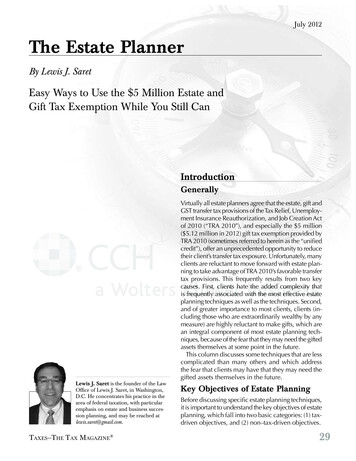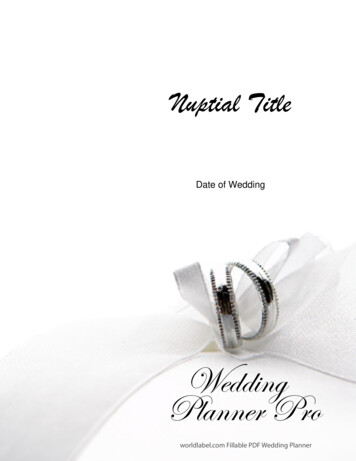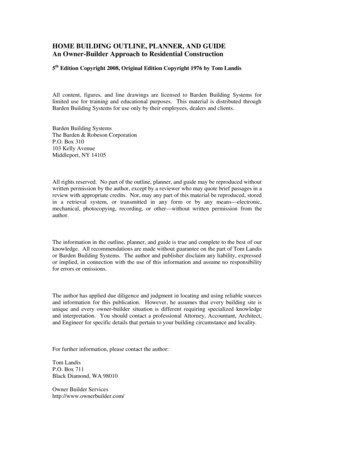
Transcription
July 2012The Estate PlannerBy Lewis J. SaretEasy Ways to Use the 5 Million Estate andGift Tax Exemption While You Still CanIntroductionGenerallyVirtually all estate planners agree that the estate, gift andGST transfer tax provisions of the Tax Relief, Unemployment Insurance Reauthorization, and Job Creation Actof 2010 (“TRA 2010”), and especially the 5 million( 5.12 million in 2012) gift tax exemption provided byTRA 2010 (sometimes referred to herein as the “unifiedcredit”), offer an unprecedented opportunity to reducetheir client’s transfer tax exposure. Unfortunately, manyclients are reluctant to move forward with estate planning to take advantage of TRA 2010’s favorable transfertax provisions. This frequently results from two keycauses.hate the addedthatauses First,rst, cclientsieents hadded complexityomplexity thiss frefrequentlyquent y associatedassociate with the most effectiveeffective estateestatplanning techniques as well as the techniques. Second,and of greater importance to most clients, clients (including those who are extraordinarily wealthy by anymeasure) are highly reluctant to make gifts, which arean integral component of most estate planning techniques, because of the fear that they may need the giftedassets themselves at some point in the future.This column discusses some techniques that are lesscomplicated than many others and which addressthe fear that clients may have that they may need thegifted assets themselves in the future.Lewis J. Saret is the founder of the LawOffice of Lewis J. Saret, in Washington,D.C. He concentrates his practice in thearea of federal taxation, with particularemphasis on estate and business succession planning, and may be reached atlewis.saret@gmail.com.TAXES—THE TAX MAGAZINE Key Objectives of Estate PlanningBefore discussing specific estate planning techniques,it is important to understand the key objectives of estateplanning, which fall into two basic categories: (1) taxdriven objectives, and (2) non–tax-driven objectives.29
The Estate PlannerTax-Driven Objectives1Giving—Tax and Other AspectsThe primary tax objectives of estate planning arethreefold:Minimize estate, GST and gift taxes imposed onclients.Defer the payment of any estate, gift or GST taxesimposed on clients.Ensure there will be sufficient liquidity to payestate taxes when they become due, especiallyfor estates containing large illiquid assets, suchas closely held businesses.There are of course various ancillary tax objectives, such as minimizing income taxation ofbeneficiaries, etc.As noted above, gifts are an integral componentof most estate planning techniques. In this regard,the gift tax system is integrated with the estate taxsystem. Gifts made during lifetime are added tothe assets included in the donor’s estate at deathto arrive at the donor’s adjusted taxable estate.A tentative estate tax is calculated based on thedonor’s adjusted taxable estate, after adding backlifetime gifts, and then any gift tax paid on suchgifts is subtracted from the estate tax due, and theunified credit (unreduced for any unified creditused during the donor’s lifetime for lifetime gifts)is subtracted from the estate tax, to result in thenet estate tax due.Non–Tax-Driven ObjectivesGenerally, clients do not engage in estate planningsolely to save taxes; they generally do so to accomplish various nontax objectives for the benefit ofpeople they care about, including themselves. Having said this, tax planning is obviously important toclients because it significantly impacts the nontaxplanning objectives.More specifically, clients engage in estate planningfor the following reasons, among others:To iincreasencreease and preserve client property duringclients’lifetimes.This includes planningclielients’t ’ lifelifetig for ts liquents’uid needseeds and retiremment plaincometaxation.andd minimizingminimizi lifetimeifeintaxation Thiscouldincludecouuld alsoainclu e protectingprotecting the clients’ assetspotentialffromm pootent t al cclaimsms of creditors,editor generally referredd to as asset protection.Providing for beneficiariesmanneriar in a mmanner suitedsuited tootheir needs. This may incincludeestablishingtrustse establish ng trusts fforrchildren who lack financial maturity or are disabled,selecting guardians for minors, etc.Providing for the potential incapacity of the clients.One of the most important nontax objectives ofvirtually all clients is addressing this fear of poverty.There is an old saying that rings true: There are twothings worse than taxes—poverty and fear of poverty.2In the estate planning context, this fear manifests itselfin clients’ reluctance to make gifts because of thefear that they may subsequently need gifted assets forthemselves in order to support their lifestyles.Therefore, the primary goal that motivates clients to engage in estate planning is to provide forthe people that they care about, which typicallyincludes spouses, lineal descendants, sometimesancestors and other relatives, and almost alwaysthe clients themselves.30Planning Pointer. Mathematically, the key elements discussed above can be shown as follows,with references to lines on page 1 of the EstateTax Return. Form 706, United States Estate (andGeneration-Skipping Transfer) Tax Return (Rev.August 2011) is included in Exhibit 1 for purposesof reference.Exhibit 1.Part 2, TaxComputation,Line No.Description3c Taxable estate (i.e., gross estate lessallowable deductions)4 Adjusted taxable gifts made bydecedent after December 31, 1976,other thanth gifts alreadyea includible indecedent’sdec ent’ grossg o s estatee ta e5 AdjustedAted taxableaxable estate.est te6 Tentative estate tax based on amount(i.e., adjusted taxable estate amount)shown on line 57-Total gift tax paid/payable withrespect to adjusted taxable gifts madeby decedent after December 31,1976, shown on line 4, to the extentthe decedent was the donor of suchgifts and such gifts were includible inthe decedent’s gross estate8 Gross estate tax9 Unified Credit10–14 Adjustments to Unified Credit andOther Credits15 Total Credits16 8-15 Net estate taxIt should be noted that one of the primary tax objec- 2012 CCH. All Rights Reserved.
July 2012tives of estate planning is to minimize, tothe greatest extent possible, the net estatetax amount reflected on line 16, takinginto consideration any gift tax paid.It should also be noted that as aresult of the foregoing calculation,lifetime gifts are advantageous froman estate planning perspective for tworeasons and possibly an additionalthird reason.Exhibit 2.Part 2, TaxComputation,Line No.Description3c 4 Taxable estate (i.e., gross estate lessallowable deductions)Adjusted taxable gifts made by decedent after December 31, 1976,other than gifts already includiblein decedent’s gross estate 300,000,000.3,000,0005 Adjusted taxable estate303,000,000Post-Gift Appreciation EscapesTransfer Tax System6 Tentative estate tax based onamount (i.e., adjusted taxableestate amount) shown on line 5106,030,800First, for gifted assets that appreciatein value, appreciation that occurs afterthe date of the gift escapes the transfertax system.7-Total gift tax paid/payable with respect to adjusted taxable gifts madeby decedent after December 31,1976, shown on line 4, to the extentthe decedent was the donor of suchgifts and such gifts were includiblein the decedent’s gross estate8 Gross estate tax9 Unified Credit10–14 Adjustments to Unified Creditand Other Credits15 Total Credits16 8-15 Net estate taxExample 1. Zach Markburg foundsan Internet startup, Yearbook.com,which grows rapidly. Zach makes agift to his son, Sonny, of 1,000 sharesof Yearbook.com stock with a 3 million fair market value on January 1,2011, and when the gift and estate taxexemptionis 5 million. As axemmptioon amountaresult,Zachreesultlt, ZaZachh payspa no gift tax upon thepgift.Yearbook.compublicgiift Yearift.Yrboookok.cgoes pblic in anIPOIPPO ono JJulyulyy 1, 2012,2 and theth valueuestockgiftedoff thee stoock ggifted too SonnySonny grows to 300as of December 3300 millionmilillilion inn valuevaecemb31, 2012. Zach retains another 1,000shares of Yearbook.comom stock.ock.Zach dies on December 31, 2012,when the gift and estate tax exemptionamount is 5.12 million. Zach’s onlyasset at his death is his own 1,000shares of Yearbook.com stock, whichas noted is worth 300 million.TAXES—THE TAX MAGAZINE 1,772,8001,772,800 104,258,000Exhibit 3.Partar 2, TaxComputation,CoLinein No.Description3cc Taxable estate (i.e., gross estate lessallowable deductions)4 Adjusted taxable ggifts mamade byydecedentafterDecember31, 11976,e edent after Dec ber 31976,otherincludibleother thanhan giftsifts alreadyly includible inndecedent’s gross estate5 Adjusted taxable estate600,000,0006 Tentative estate tax based on amount(i.e., adjusted taxable estate amount)shown on line 5209,980,8007-Total gift tax paid/payable with respectto adjusted taxable gifts made bydecedent after December 31, 1976,shown on line 4, to the extent thedecedent was the donor of such giftsand such gifts were includible in thedecedent’s gross estate8 Gross estate tax9 Unified Credit10–14 Adjustments to Unified Credit andOther Credits15 Total Credits16 8-15 Net estate taxHere, as shown in Exhibit 2, Zach’sestate will pay an estate tax, assumingno state estate tax, of 104,300,000.Example 2. Same facts, except thatZach does not make a gift to Sonny,and retains 2,000 shares of Yearbook.com. Here, as shown in Exhibit 3,Zach’s estate will pay an estate tax of 208,208,000, or in other words, Zach’s0106,030,800 600,000,000.0209,980,8001,772,8001,772,800 208,208,00031
The Estate PlannerExhibit 4.Part 2, TaxComputation,Line No.3cestate pays 103,950,000 more than inExample 1. In other words, by making agift during 2011, Zach could save over 100 million in transfer taxes.Description Taxable estate (i.e., gross estate less allowable deductions)4 Adjusted taxable gifts made by decedentafter December 31, 1976, other than giftsalready includible in decedent’s gross estate5 Adjusted taxable estate6 Tentative estate tax based on amount(i.e., adjusted taxable estate amount)shown on line 57-Total gift tax paid/payable with respect toadjusted taxable gifts made by decedentafter December 31, 1976, shown on line4, to the extent the decedent was thedonor of such gifts and such gifts wereincludible in the decedent’s gross estate 32,626,70032,626,7001,400,44508 Gross estate tax1,400,4459 Unified Credit1,772,80010–14 Adjustments to Unified Credit and OtherCredits15 Total Credits16 8-15 Net estate tax1,772,800 9,627,345Exhibitxhhibiitit 5.5Partt 2,2 TaxTComputation,Commputationn,No.Linee NoLiNDescriptionesc3c Taxableestateable estae (i.e., ggrossoss estate lessallowable deductions)4 Adjusted taxableable giftgifts maded bbydecedentDecember31,1976,ent afterer Decembe 31, 1976,other thathan giftsalreadyincludiblets alredy includible inndecedent’s gross estate5 Adjusted taxable estate6 Tentative estate tax based on amount(i.e., adjusted taxable estate amount)shown on line 57-Total gift tax paid/payable with respectto adjusted taxable gifts made bydecedent after December 31, 1976,shown on line 4, to the extent thedecedent was the donor of such giftsand such gifts were includible in thedecedent’s gross estate 16,313,3503,500,000Example 4. Same facts as Example 3,except that Harold makes a gift of 3.5million to a trust for Dolly’s benefit in2012. Here, at Harold’s death, as shownin Exhibit 5, Harold’s estate yields anestate tax of 5,142,673. Therefore, bymaking a gift of 3.5 million to Dolly,Harold saves 4,448,672 in estatetaxes, which flows through entirely toDolly rather than to the government.As the foregoing examples illustrate,when clients make gifts during lifetime,appreciationongiftedall appre atio n on ttheh gifted aassetsseescapetaxationescape eestatee taxation aandd ccanan resultresult iinsubstantial savings for the family unit.19,813,3506,915,473Assets Used to Pay Gift Taxes NotSubject to Estate Tax;Assets Used to Pay Estate TaxAre Subject to Estate Tax0Second, if clients make gifts that resultin a taxable gift then the amount offunds used to pay gift tax further reducethe donor’s taxable estate and furtherreduce the transfer taxes that apply tothe family unit.8 Gross estate tax6,915,4739 Unified Credit1,772,80010–14 Adjustments to Unified Credit andOther Credits15 Total Credits16 8-15 Net estate tax32Example 3. Harold Professional, a successful professional, lives frugally andhas accumulated 7 million of assetsas of January 1, 2012. Harold’s assetsgrow at an eight-percent rate after taxesfor 20 years at which point Harolddies in 2032 owning assets with a fairmarket value of 32,626,700. Harold’sassets pass to his daughter, Dolly. Assuming that the estate tax is exactlythe same in 2032 as in 2012, Harold’sestate tax would be 9,627,345, asshown in Exhibit 4.1,772,800 5,142,673Example 5. Same facts as Example 4,except that Harold makes a gift of 6million in 2012 to a trust for Dolly’s 2012 CCH. All Rights Reserved.
July 2012benefit. Here, Harold would have to paya gift tax in 2012 of 308,000, whichwould reduce Harold’s taxable estate.The result would be that his assets at hisdeath in 2032 would equal 3,225,382,which would result in estate tax of 1,128,884, as shown in Exhibit 6.Therefore, in this Example, Harold’s totaltransfer tax exposure is 1,436,884, asopposed to 5,184,673 in Example 4,and 9,627,345 in Example 3.Clawback or No ClawbackExhibit 6.Part 2, TaxComputation,Line No.3c Taxable estate (i.e., gross estate less allowable deductions)4 Adjusted taxable gifts made by decedentafter December 31, 1976, other thangifts already includible in decedent’sgross estate 3,225,3826,000,0005 Adjusted taxable estate9,225,3826 Tentative estate tax based on amount(i.e., adjusted taxable estate amount)shown on line 53,209,6847-Total gift tax paid/payable with respect toadjusted taxable gifts made by decedentafter December 31, 1976, shown on line4, to the extent the decedent was thedonor of such gifts and such gifts wereincludible in the decedent’s gross estate Gross estate tax2,901,684 Unified Credit1,772,800 Adjustments to Unified Creditand Other Credits Total CreditsAs noted above, upon death, lifetimegifts made after 1976 are added tothe decedent’s estate, using the valuesas of the date of gift, to arrive at anadjusted taxable estate amount, upon 8which the estate tax is based. As also 9noted, post gift appreciation of assets 10–14that the decedent/donor gifted duringlifetime is not added to estate. There- 15fore, post-gift appreciation escapes 16transfer taxation with respect to thedecedent/donor.deent/ddoO openOneo n issiissuesue is whether, if the 5 million ( 5.12million2012)exemptionreduced aftermillion for 2012) gift taxax exemmption iis reduceDecember2012, to somethan 5Deccember 31, 20e amountt less thmillionmillion ( 5.12( 5.12 millionmill n for 2012),2012), giftsgif made during2012thatexceed ththe exemptiondeathbutt ddid not12 thhatt eexceempt n at deth bexceed theh exemption amount in 2012 must be addedto the decedent’s taxablee estatee te as ofof datedate of death.death.In other words, if the estateate andd gift taxax exemptionexemption issreduced below 5 million ( 5.12 million for 2012)in the future (and under current law, the exemptionis scheduled to decline after December 31, 2012, to 1 million), any amounts transferred during life maybe “clawed back” into the estate and gift transfer taxsystem without the protection of the 5 million ( 5.12million for 2012) exemption amount.3Many commentators believe that if the exemptionamount is reduced, that a clawback would be inconsistent with congressional intent and, therefore,is unlikely to occur. If this view prevails and there isno clawback, any gifts during 2012 that exceed anyfuture reduced exemption amount will permanentlyescape transfer taxation with respect to the donorand possibly future generations.If there is a clawback, then the donor will generally be in no worse transfer tax position than if theTAXES—THE TAX MAGAZINE Description 8-15 Net estate tax308,0001,772,800 1,128,884donor had not made a gift, with one key exception.That exception is the need to plan for sufficientliquidity in the donor’s estate to satisfy any estatetaxes that result from any potential clawback withrespect to the gifted assets, which necessarily wouldnot then be directly available in the donor’s estatetoestateliability.o useu e to satisfy the associateda ociated esate tax liabiityCaution. It is important to clearly explain theissue of the potential clawback to clients. Somecommentators have expressed the opinion, basedon conversations with Congressional staffers, thatthere will be no clawback. Notwithstanding suchopinions, there is no guarantee that a clawbackwill not occur. Therefore, it is important for practitioners to discuss the risk of such a clawback andthe impact of such possibility with clients.Summary of Client ObjectivesRegarding Estate PlanningAt the end of the day, clients are motivated to engagein estate planning because they want to provide fortheir loved ones and to preserve and protect familybusinesses. Although nobody likes paying taxes, taxes33
The Estate Plannerare not, in and of themselves, typically a direct motivating factor. Instead, tax planning is indirectly importantbecause funds used to pay taxes cannot be left for thebenefit of loved ones and requires planning to ensurethat there are sufficient funds to cover estate taxes toavoid the need to dispose of liquid assets, such as family-owned businesses. The importance of this distinctionis that many clients deeply resent and dislike what theyperceive to be complicated estate planning techniques,which they think unnecessarily complicates their livesand the way that they run their businesses. In turn, thisincreases the reluctance of some clients to engage inmore sophisticated estate planning.As we have seen, lifetime gifts result in greater taxsavings than transfers of assets at death. On the otherhand, clients generally are reluctant to make inter vivos gifts because of the fear that they may need suchassets for themselves during their lifetimes.4Furthermore, advisors have a professional obligation to advise their clients about how to takeadvantage of the 5 million ( 5.12 million for 2012)exemption. How should they proceed?With the foregoing in ming, some clients who areresistant to sophisticated estate planning techniquesmay be more receptive to the following estateplanningwhich allow them to take adnninng techniques,teechnvantageantagee off theh 5 million ( 5.12 million for 2012)exemptionofxempttion whilewhile avoidingding mostmost of the complexitycomplemoresophisticatedtechniques:morre soophip isticate estatesta planningnchniquSpousalLimitedTrusts(SLATs)Spoousal Limmitted Accessccess Tusts (SLATIntervivosCreditIInteter vivivoss Cedd Shelterelter TrustsstsNonreciprocal SLATs and NonreciprocalInterpvivos Credit Shelter TrusTrustsSLATsOne easy way for clients to make gifts that willremove the gifted property from their estates is tomake gifts to a SLAT. In essence a SLAT is simply anirrevocable trust established by one spouse for thebenefit of the other spouse. The key benefit of a SLATis that the assets gifted to the SLAT are removed fromthe donor’s taxable estate but at the same time suchgifted property remains available to the family unitthrough the spousal beneficiary.SLAT StructureSeparate PropertyFirst, the SLAT grantor must use separate propertyto fund the SLAT. Failure to use separate property34when funding SLATs will cause the SLAT assets tobe included in the nongrantor spouse’s taxable estateunder Code Sec. 2036.Planning Pointer. Planners should clearly document the origin of funds used to create and fundSLATs to avoid any issue in the future.Standard of PaymentSome commentators have raised an issue concerning the standard used for making distributionsto the spouse/beneficiary and whether an ascertainable standard applied to such payments mayaccidentally cause estate inclusion of some or all ofthe trust assets in the spouse/beneficiary’s estate.5Specifically, Reg. §20.2036-1(b)(2) provides asfollows:The “use, possession, right to the income, or otherenjoyment of the transferred property” is consideredas having been retained by or reserved to the decedent to the extent that the use, possession, right to theincome, or other enjoyment is to be applied towardthe discharge of a legal obligation of the decedent, orotherwise for his pecuniary benefit. The term “legalobligation” includes a legal obligation to support adependent during the decedent’s lifetime.Essentially, Reg. §20.2036-1(b)(2) provides thatthere is estate inclusion of trust assets if such assets areto be used to discharge the grantor’s support or otherlegal obligations, which could include the grantor’slegalega obligationobligation to supportsup ort his/herhis/her spouse.pousee.haveIn interpretingnterp eting Reg.Reg §20.2036-1(b)(2),0.2036-1(b) 2), courtschavset forth the following key principals:6Mandatory distributions. If the trust instrumentmandates distributions for grantor’s spouse forpurposes of providing support, then there is estateinclusion under Code Sec. 2036.7Discretionary Distributions. If the trustee hasdiscretion to make distributions for support purposes, there is estate inclusion if the grantor isthe trustee8 but no inclusion if there is an independent trustee.9Support Standard. If the trust instrument does nothave a support standard then there is no Code Sec.2036 inclusion regardless of whether distributionsto the spouse are discretionary or mandatory.10However, if the spouse is trustee, then lack of anascertainable standard will result in inclusion inthe spouse’s estate under Code Sec. 2041. 2012 CCH. All Rights Reserved.
July 2012Planning Pointer. Prudent planners will includelanguage in their trust agreements that prohibitdistributions to the grantor’s spouse that dischargethe grantor’s legal obligation of support. However, an independent trustee can be appointedto distribute income or principal to the spousefor any purpose.TrusteeTo avoid Code Sec. 2036 inclusion, planners shoulduse someone other than the grantor as trustee. Although the grantor’s spouse can serve as trustee if his/her ability to distribute is subject to an ascertainablestandard, it is preferable to use an independent trusteeas either sole trustee or co-trustee.Dispository StructureUnlike certain other estate planning techniques, suchas GRATs and charitable remainder trusts (CRTs),which are well defined under the Code, SLATs apparently arose as a marketing concept and are notdefined under the Code. As a result, the conceptof a SLAT is somewhat vague. Commentators havedescribed SLATs as having characteristics rangingfrom characteristics virtually identical to a qualifiedterminalinterestminaal inttere property (QTIP) marital trust to characteristicscteeristi icsi virtuvvirtuallyi ua identical to a credit shelter trustthathatt includesinccludes tthehe spouseuse as a beneficiary. TheTh twothingsof a SLAThinngsg ini commoncoommmo to alla descriptionscriSL arethathatt (1) the spousespoouse is a beneficiary, anda d (2) the SLATis structuredthat it is not includedttructtured tot ensurensi l d d in thetaxable estates of either the grantor or the spouse.11Advantages of SLATLATFirst, the primary benefit of a SLAT is that it can beused to mitigate the donor’s estate tax exposure byallowing the grantor to make a completed gift tothe SLAT with the gifted assets removed from thedonor’s estate and with such assets excluded fromthe spouse’s estate.12Second, SLATs allow the assets contained in theSLAT to be available to the family unit because thespouse is a SLAT beneficiary and may serve as eithera sole or co-trustee.13 This addresses in large part theconcern of most clients that they may need assets,which they are contemplating using to make a gift,in the future.Third, SLATs generally protect the assets in the SLATfrom creditors of both spouses assuming that thetransfer into the SLAT is not a fraudulent conveyanceby the grantor. A fraudulent conveyance is generallyTAXES—THE TAX MAGAZINE a transfer of property intended to hinder, delay or defraud creditors. Although a full discussion of fraudulentconveyances is beyond the scope of this column, if thefunding of the SLAT is not intended to defraud creditorsand does not leave the grantor insolvent, then the transfer should not constitute a fraudulent conveyance.Example 6. Kristin, a successful high-tech entrepreneur, creates a SLAT for her husband, Sam, andtransfers into a SLAT 5 million in stock in herlatest venture, Startup Inc. in 2011. The transferuses up Kristin’s full 5 million exemption. Thestock placed into the SLAT sells for 10 million,which remains in the SLAT.In 2016 Kristin founds a new startup, Second Act,Inc., which fails spectacularly in 2017. Kristin issued and a judgment in the amount of 10 million is entered against Kristin, forcing her intobankruptcy in 2018. Here, the assets in the SLATshould not be exposed to creditors.Example 7. Same facts as Example 6 except thatit is Sam who founds Second Act, Inc., and whois forced into bankruptcy in 2018. The resultshould be the same. Namely, the assets in theSLAT should not be exposed to Sam’s creditors.Disadvantages of SLATFirst, one obvious disadvantage of a SLAT is that ifthe spousepredeceases the grantor, the grantor losespaccessassets.his iindirectnd rect acceess too tthee trust assesPlanning Pointer. One easy solution to the issueof the grantor losing indirect access to SLAT assets through the spousal beneficiary is to havethe spouse create an irrevocable life insurancetrust for the benefit of the grantor of the SLAT forthe purpose of replacing the access to the assetstransferred into the SLAT.Second, the grantor’s access to SLAT assets is contingent on the quality of the marriage. In a worst-casescenario, if the spouse’s divorce, the grantor’s indirectaccess to SLAT assets terminates. Therefore, for clientswith unstable marriages, SLATs are not an appropriateestate planning vehicle.Planning Pointer. To mitigate the risk of divorce, planners should consider including in the SLAT instrument35
The Estate Plannera provision either (1) defining the SLAT beneficiary asthe grantor’s then current spouse, which would notinclude a spouse after divorce; or (2) terminating theSLAT upon divorce with SLAT assets then droppingdown into trusts for lineal descendants.that even if the grantor is successful from a transfertax standpoint in appointing property back to thegrantor in trust with such appointed assets excludedfrom the estates of the grantor and the spouse, suchan exercise could expose the appointed assets tothe claims of the grantor’s creditors.Inter vivos Credit Shelter TrustGenerallyAdvantages and Disadvantages ofInter vivos Credit Shelter TrustA variation on the above described SLAT strategy is tocreate an inter vivos credit shelter trust for the benefitof the grantor’s spouse and lineal descendants. Thisgenerally has the same benefits as those describedabove for SLATs (i.e., removal of assets from the estateof the grantor and the estate of the grantor’s spouse;indirect access to the trust assets through the spousalbeneficiary; and protection of trust assets from creditorsof both spouses). However, inter vivos credit sheltertrusts have an additional benefit. Because most marriedclients have estate plans that incorporate credit sheltertrusts, clients generally will be more familiar with suchtrusts than other estate planning vehicles and may bemore receptive to lifetime planning with such trusts.Nonreciprocal SLATs andNonreciprocal Inter vivosCredit Shelter TrustsStructureGenerallyAn internterr vivvivosvos credit shelter trust generally would bestructuredructurredd usingu i g terms that are veryy similar to thoseusincontainedtestamentarycreditshelterr trusts. GGenerontained inn tesstaary credit shelteally,theyarefor the bebenefit off the gragrantor’slly,y, theeyy arre ccreatedreafospousepouse and lineallineea descendants.de cendants. AmongAmong other tthings,the grangrantor’sspousenttor’’’s spuse can:be a didiscretionary beneficiary of the trust.be a trustee, either a soledistribuole trusteestee as longg as distributions are subject to anascertainablestandard,n asainable standard, oro aco-trustee along with an independent trustee.have a limited power of appointment over trustassets.Some clients may desire to establish not just onebut two trusts, one for each spouse in order to takeadvantage of each spouse’s unified credit. Here,the issue presented is whether the reciprocal trustdoctrine would apply and cause each spouse to betreated as the grantor of the other spouse’s trust andthereby potentially causing estate inclusion.15Generally,Gen r lly, thethe reciprocalreccip cal trusttrust doctrinedoctrine is a judiudciallythatiallyy createdcreated doctrinedoctritha maymay applyapply whenwhen twotwgrantors create virtually identical trusts at the sametime, and there is a crossing of beneficial interests orpowers. Here, the IRS may try to uncross the transfersand thereby include the principal of one Grantor’strust in the other Grantor’s estate.Planning Pointer. As noted, the grantor can givethe spouse a limited power of appointment. Sucha limited power of appointment could be broadenough to encompass virtually anyone other thanthe spouse, the spouse’s creditors, or the creditorsof the spouse’s estate and still be excluded fromthe spouse’s estate for estate tax purposes.14 Therefore, the spouse could even be given a limitedpower of appointment that would be sufficientlybroad enough to appoint trust assets back to thegrantor as long as it can be shown that there wasno prearrangement with the spouse to so exercisethe power of appointment. Also it should be noted36Generally, the advantages and disadvantages of an intervivos credit shelter trust
gift to his son, Sonny, of 1,000 shares of Yearbook.com stock with a 3 mil-lion fair market value on January 1, 2011, and when the gift and estate tax exemption amount is 5 million. As a result, Zach pays no gift tax upon the gift. Yearbook.com goes public in an IPO on July 1,











